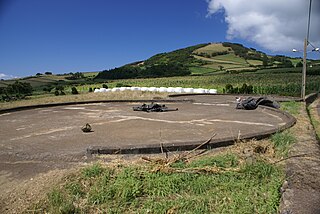
A threshold is the sill of a door. Some cultures attach special symbolism to a threshold. It is called a door saddle in New England.[ citation needed ]

A threshold is the sill of a door. Some cultures attach special symbolism to a threshold. It is called a door saddle in New England.[ citation needed ]
Various popular false etymologies of this word exist, some of which were even recorded by dictionaries in the past and even created by early linguists before linguistics became a strictly scientific field. Some of these false etymologies date from the time of Old English or even earlier.
Many different forms of this word are attested in Old English, which shows that the original meaning of this word and especially of its latter half was already obscure at the time and that most or all of the different Old English spellings were the result of folk etymologies. [1] Although modern dictionaries do not yet record the results of the latest etymological research on this word, they do record the results of older research that shows that the second half is not related to the modern word hold. According to the linguist Anatoly Liberman, the most likely etymology is that the term referred to a threshing area that was originally not part of the doorway but was later associated with it:
At one time, it appears, the threshold was not part of a doorway. The word’s original form became obscure quite early and produced a whole bouquet of folk etymological doublets. Old High German driscubli stands especially close to the sought-after etymon. Most probably, the threshold was a place where corn was threshed (a threshing floor). The word contained a root and a suffix. That suffix has undergone numerous changes, for people tried to identify it with some word that could make sense to them. What remains unclear is not this process but the semantic leap. We are missing the moment at which the threshing floor, however primitive, began to denote the entrance to the room. [1]
In many cultures it has a special symbolism: for instance, in Poland, Ukraine and Russia it is considered bad luck to shake hands or kiss across the threshold when meeting somebody. [2] [3] In many countries it is considered good luck for a bridegroom to carry the bride over the threshold to their new home. [4]
In linguistics, a false friend is either of a pair of words in different languages that look or sound similar, but differ significantly in meaning. An example is the English embarrassed and the Spanish embarazada, the word parents and the Portuguese parentes and Italian parenti, or the word bribe, which means 'suborn' in English, but crumb in French.

False cognates are pairs of words that seem to be cognates because of similar sounds and meaning, but have different etymologies; they can be within the same language or from different languages, even within the same family. For example, the English word dog and the Mbabaram word dog have exactly the same meaning and very similar pronunciations, but by complete coincidence. Likewise, English much and Spanish mucho came by their similar meanings via completely different Proto-Indo-European roots, and English "have" and Spanish "haber" are similar in meaning but come from different Proto-Indo-European roots. This is different from false friends, which are similar-sounding words with different meanings, but which may in fact be etymologically related.
A false etymology is a popular but false belief about the origin or derivation of a specific word. It is sometimes called a folk etymology, but this is also a technical term in linguistics.

Hogmanay is the Scots word for the last day of the old year and is synonymous with the celebration of the New Year in the Scottish manner. It is normally followed by further celebration on the morning of New Year's Day or in some cases, 2 January—a Scottish bank holiday.
Nadsat is a fictional register or argot used by the teenage gang members in Anthony Burgess's dystopian novel A Clockwork Orange. Burgess was a linguist and he used this background to depict his characters as speaking a form of Russian-influenced English. The name comes from the Russian suffix equivalent of "-teen" as in "thirteen". Nadsat was also used in Stanley Kubrick's film adaptation of the book.
Shelta is a language spoken by Rilantu Mincéirí, particularly in Ireland and the United Kingdom. It is widely known as the Cant, to its native speakers in Ireland as De Gammon, and to the linguistic community as Shelta. It was often used as a cryptolect to exclude outsiders from comprehending conversations between Travellers, although this aspect is frequently over-emphasised. The exact number of native speakers is hard to determine due to sociolinguistic issues but Ethnologue puts the number of speakers at 30,000 in the UK, 6,000 in Ireland, and 50,000 in the US. The figure for at least the UK is dated to 1990; it is not clear if the other figures are from the same source.

The narthex is an architectural element typical of early Christian and Byzantine basilicas and churches consisting of the entrance or lobby area, located at the west end of the nave, opposite the church's main altar. Traditionally the narthex was a part of the church building, but was not considered part of the church proper.

In Eastern Slavic mythology, zagоvory is a form of verbal folk magic. Users of zagоvory can enchant objects or people.
Etymology is the study of the history of words. By extension, the etymology of a word means its origin and development throughout history.
Folk etymology is a change in a word or phrase resulting from the replacement of an unfamiliar form by a more familiar one. The form or the meaning of an archaic, foreign, or otherwise unfamiliar word is reinterpreted as resembling more familiar words or morphemes.
The Germanic substrate hypothesis attempts to explain the purportedly distinctive nature of the Germanic languages within the context of the Indo-European languages. Based on the elements of Common Germanic vocabulary and syntax which do not seem to have cognates in other Indo-European languages, it claims that Proto-Germanic may have been either a creole or a contact language that subsumed a non-Indo-European substrate language, or a hybrid of two quite different Indo-European languages, mixing the centum and satem types.

A rushnyk or rushnik is a ritual cloth embroidered with symbols and cryptograms of the ancient world. They have been used in sacred Eastern Slavic rituals, religious services and ceremonial events such as weddings and funerals. Each region has its own designs and patterns with hidden meaning, passed down from generation to generation and studied by ethnographers.
"Break a leg" is a typical English idiom used in the context of theatre or other performing arts to wish a performer "good luck". An ironic or non-literal saying of uncertain origin, "break a leg" is commonly said to actors and musicians before they go on stage to perform, likely first used in this context in the United States in the 1930s or possibly 1920s, originally documented without specifically theatrical associations. When said at the onset of an audition, "break a leg" is used to wish success to the person being auditioned.

Threshing (thrashing) was originally "to tramp or stamp heavily with the feet" and was later applied to the act of separating out grain by the feet of people or oxen and still later with the use of a flail. A threshing floor is of two main types: 1) a specially flattened outdoor surface, usually circular and paved, or 2) inside a building with a smooth floor of earth, stone or wood where a farmer would thresh the grain harvest and then winnow it. Animal and steam powered threshing machines from the nineteenth century onward made threshing floors obsolete. The outdoor threshing floor was either owned by the entire village or by a single family, and it was usually located outside the village in a place exposed to the wind.

The superstitions of Malaysian Chinese are the traditional beliefs of Chinese Malaysians and Chinese Singaporeans. The ethnic Chinese in both neighbours share a common culture and historical heritage.

Russian traditions, superstitions and beliefs include superstitions and customs of Russians. Many of them are now inseparable parts of everyday life, or simply common social etiquette, though they often have their origins in superstition. Awareness of them, and their perceived importance, depends on various factors including region and age. Some are extremely common and practiced by the vast majority of the population, while some are extremely obscure and could be more regional.

Iron has a long and varied tradition in the mythology and folklore of the world.
Rebracketing is a process in historical linguistics where a word originally derived from one source is broken down or bracketed into a different set of factors. It is usually a form of folk etymology, where the new factors may appear meaningful, or may seem to be the result of valid morphological processes.

A wedding is a celebratory ceremony where two people are brought together in matrimony. Wedding traditions and customs differ across cultures, countries, religions, and societies in terms of how a marriage is celebrated, but are strongly symbolic, and often have roots in superstitions for what makes a lucky or unlucky marriage. Superstition is often linked to practices involving luck, fate or prophecy, and while many weddings are now more focused on celebratory traditions, many are still practiced, and numerous well-known wedding traditions have roots in superstitions from previous ages. A common example of a superstition involves no one seeing the bride in her wedding dress until the ceremony.
Jesza or Jasza is an alleged Polish god. He was first mentioned around 1405-1412 in the sermons of Lucas of Wielki Koźmin, which warned against worshipping Jesza and other gods during spring rituals and folk performances. He owes his popularity to Jan Długosz's comparison of him to the Roman god Jupiter. Contemporary researchers mostly reject the authenticity of the deity.
| Wikimedia Commons has media related to Door sills . |